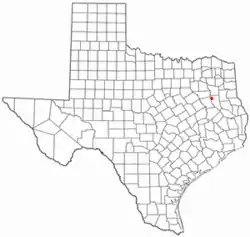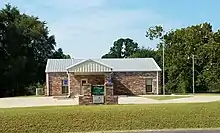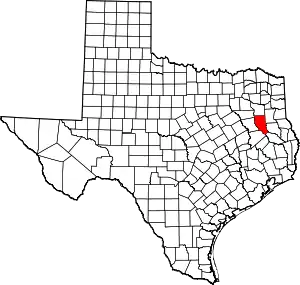Cuney, Texas
Cuney is a town located in northwest Cherokee County, Texas, United States. The population was 140 at the 2010 census.[5]
Cuney, Texas | |
|---|---|
 Location of Cuney, Texas | |
 | |
| Coordinates: 32°2′3″N 95°25′4″W | |
| Country | United States |
| State | Texas |
| County | Cherokee |
| Government | |
| • City Council | Mayor: Jesse Johnson Aldermen -- Place 1: Place 2: Diane Reed Place 3: Place 4: Elizabeth Jenkins |
| Area | |
| • Total | 1.64 sq mi (4.26 km2) |
| • Land | 1.64 sq mi (4.26 km2) |
| • Water | 0.00 sq mi (0.00 km2) |
| Elevation | 374 ft (114 m) |
| Population (2010) | |
| • Total | 140 |
| • Estimate (2019)[2] | 140 |
| • Density | 85.21/sq mi (32.89/km2) |
| Time zone | UTC-6 (Central (CST)) |
| • Summer (DST) | UTC-5 (CDT) |
| ZIP code | 75759 |
| Area code(s) | 430, 903 |
| FIPS code | 48-18152[3] |
| GNIS feature ID | 1333813[4] |
Cuney was the only "wet" town in Cherokee County from the mid-1980s until 2009, when voters in Rusk came out in favor of beer/wine sales. After that result, voters in Jacksonville and Frankston have since voted in favor of beer/wine sales, and Rusk voters returned to the polls to vote in favor of liquor sales. As of 2020, only one liquor store remains in Cuney.
Geography
Cuney is located at 32°2′3″N 95°25′4″W (32.034127, -95.417769).[6] It is situated just west of the junction of U.S. Highway 175 and FM 855 in northwestern Cherokee County, about 10 miles (16 km) northwest of Jacksonville, 24 miles (39 km) northwest of Rusk,[7] and 28 miles (45 km) southeast of Athens.

According to the United States Census Bureau, the town has a total area of 1.64 square miles (4.26 km2), all of it land. The Neches River forms the northwest border of the town and the Cherokee/Anderson County line.
History
The site was first settled by freed slaves just after the Civil War. The settlement was initially known as Andy, after Andrew "Andy" Bragg, one of the area's first black homeowners. He arrived in 1870.[8] A community did not develop until 1902, when the site became a flag stop on the Texas and New Orleans Railroad, which became part of the Southern Pacific system in 1961. Around 1914, Palestine cashier H.L. Price and several local investors formed a company and platted a town site. They named the town Cuney, after Price's son, Cuney Price, who in turn had been named for Norris Wright Cuney, a prominent black politician and head of the state's Republican Party.[9] A post office was established in 1917 and a number of businesses were operating in the community by the early 1920s. With the paving of State Highway 40 in 1929, which would eventually become U.S. Highway 175, most of the businesses moved a mile north of the railroad to take advantage of the increased traffic. The population was estimated at 100 in 1929, but declined to only 25 by the mid-1930s. A number of businesses closed after World War II as agricultural prices decreased and residents moved to other cities with greater employment opportunities. Cuney had a population of 75 in the early 1950s. From that period, the community steadily grew, and Cuney was incorporated in November 1983.[7][9] In the 1990 census, the town had 170 residents. That number had fallen to 145 by 2000.
Government
The Joe W. Arnwine Municipal Business Center contains Cuney's city hall, police department, and municipal court facilities.
The U.S. Postal Service operates a post office in Cuney, just east of Cuney City Hall.
Demographics
| Historical population | |||
|---|---|---|---|
| Census | Pop. | %± | |
| 1990 | 170 | — | |
| 2000 | 145 | −14.7% | |
| 2010 | 140 | −3.4% | |
| 2019 (est.) | 140 | [2] | 0.0% |
| U.S. Decennial Census[10] | |||
As of the census[3] of 2000, 145 people, 59 households, and 36 families resided in the town. The population density was 88.6 people per square mile (34.1/km2). The 78 housing units averaged 47.7 per square mile (18.4/km2). The racial makeup of the town was 11.03% White, 83.45% African American, 0.69% Native American, 0.69% Asian, 0.69% from other races, and 3.45% from two or more races. Hispanics or Latinos of any race were 0.69% of the population.
Of the 59 households, 27.1% had children under the age of 18 living with them, 28.8% were married couples living together, 23.7% had a female householder with no husband present, and 37.3% were not families. About 27.1% of all households were made up of individuals, and 11.9% had someone living alone who was 65 years of age or older. The average household size was 2.46 and the average family size was 3.11.
In the town, the population was distributed as 32.4% under the age of 18, 2.1% from 18 to 24, 26.2% from 25 to 44, 24.8% from 45 to 64, and 14.5% who were 65 years of age or older. The median age was 38 years. For every 100 females, there were 98.6 males. For every 100 females age 18 and over, there were 88.5 males.
The median income for a household in the town was $18,333, and for a family was $17,500. Males had a median income of $18,438 versus $22,083 for females. The per capita income for the town was $7,612. There were 35.0% of families and 37.1% of the population living below the poverty line, including 43.4% of under eighteens and 44.8% of those over 64.
Education
For many years, Cuney had its own school, but is now served by the Jacksonville Independent School District.
References
- "2019 U.S. Gazetteer Files". United States Census Bureau. Retrieved August 7, 2020.
- "Population and Housing Unit Estimates". United States Census Bureau. May 24, 2020. Retrieved May 27, 2020.
- "U.S. Census website". United States Census Bureau. Retrieved 2008-01-31.
- "US Board on Geographic Names". United States Geological Survey. 2007-10-25. Retrieved 2008-01-31.
- "Geographic Identifiers: 2010 Census Summary File 1 (G001): Cuney town, Texas". U.S. Census Bureau, American Factfinder. Archived from the original on February 13, 2020. Retrieved July 27, 2015.
- "US Gazetteer files: 2010, 2000, and 1990". United States Census Bureau. 2011-02-12. Retrieved 2011-04-23.
- "Cuney, Texas". Texas Escapes Online Magazine. Retrieved 2009-08-19.
- "Cuney, Texas". Cherokee County, TXGenWeb. Retrieved 2009-08-19.
- "Cuney, Texas". The Handbook of Texas online. Retrieved 2009-08-19.
- "Census of Population and Housing". Census.gov. Retrieved June 4, 2015.
External links
- Cuney, TX from the Handbook of Texas Online
- Cuney historical marker from Texas Historic Sites Atlas (Texas Historical Commission)
